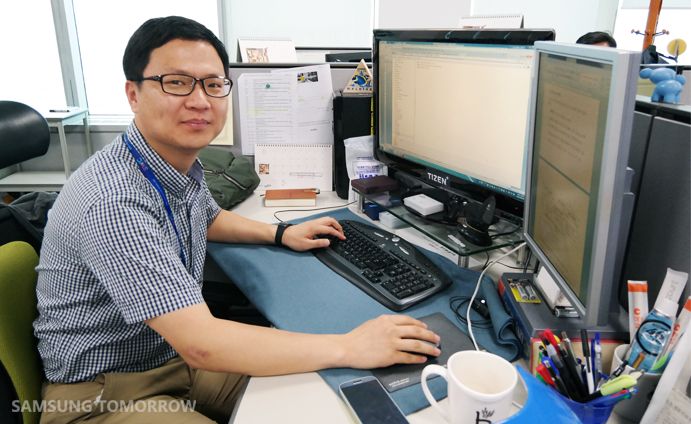Soohong Daniel Park, on board the Board of W3C (Part 2)
on July 30, 2014
Soohong Daniel Park, Senior Researcher at the Software Center of Samsung Electronics, was elected as one of the nine Advisory Board members of the W3C (World Wide Web Consortium). Before going onto his story, we’ve covered some basic information about W3C, Web, and Web Standards in the previous article.
Following the first piece, many of you might be curious about Park’s story. Since when and why was he interested in Web Standards? What was the process in becoming involved in the W3C like and what’s his role as the AB member from now on? The full story comes here.
Where did his Love of the Web Standards start
To be elected as an Advisory Board member of the W3C, one should have substantial research records and receive positive reviews from W3C members. When did he become interested in Web Standards and involved the W3C?
“It was just for the love of the Internet,” said Park, about his motivation. Back in the early days when he joined Samsung, he started research on Internet and Web Standards by carrying out a series of short-term projects. In the process of conducting related tasks, he found the significance of the international consortiums such as W3C.
▲Soohong Daniel Park was elected as an Advisory Board member of the W3C.
“The world of the Web consists of documents full of information. And to properly share the information, Web Standards are essential,” he explained further, mentioning the reason Tim Berners-Lee founded the W3C.
When Berners-Lee first invented the Web, he enabled its spread by opening the web technology in order for everyone to access the web and share its benefits. However, as the Web became popular, various web browsers appeared and competed with each other, adding their own and exclusive HTML technologies. Thus, depending on the web browser used, certain web elements were not applicable and the same web page was viewed differently by users. This hampered the ‘universality of the web’ which Berners-Lee originally intended. As he realized the problem he formed an organization with corporations and associations related to the Web, to discuss and establish the Web Standards. As a result, the W3C was founded in 1994.
By arranging existing HTML technologies, W3C announced HTML 2.0 in 1995 as a standard markup language. Beginning from it, W3C has been developing HTML standards and HTML 5 is at work at present. A variety of technical specifications and guidelines including CSS (Cascading Style Sheet) and DOM (Document Object Model) are being created as well.
|
*Note: Core Technologies of Web Standards Today, HTML 5, CSS 3, and JavaScript are mainly used as core technologies for developing web pages. While HTML is used to make content such as text, images, and videos and to build the structure of the document, CSS defines the design and the style of the webpage as maintaining the whole document’s consistency. And by JavaScript, you can control the webpage and make it dynamic in terms of interaction with the user. |
|
*Note: Advantages of using Web Standards Complying with web standards can give your web pages greater accessibility, better SEO (Search Engine Optimization), easier site maintenance, and cross browsers and platform compatibility. Use of web standards makes it easier for browsers to understand the basic structure of your documents and give the better search results. And complying with web standards helps make the content accessible to a wider range of users including those with disabilities, poor vision, older users, and those without the software or hardware to fully view all your website content. In addition, not only does it make your website maintenance much easier with fewer HTML tags, it helps your webpage be displayed correctly on all devices (PC, mobile, PDAs, etc.). (Source: webstandards.org) |
On board the Board of W3C
Since Park realized the importance of Web Standards, he started trying to get involved in the W3C. In 2006, Samsung Electronics became a member of W3C and Park has worked as Samsung’s Representative. However, even though Samsung was one of the largest corporations globally known, Park was not well recognized by W3C members at first since Samsung hadn’t been actively involved in the software field at that time. But, for Park, that was like an adventure to thrive on. Because Web Standards were what he really enjoyed doing, he worked harder and made an earnest effort.
Before long, Park’s effort bore fruit. In March 2008, he was elected as Chair of Media Annotation Working Group in W3C. (Here is more info about the W3C Groups.) And this year, he was elected as an Advisory Board member. He is now responsible for research activities on Web Standards in a broader range as well as attending regular meetings of the W3C, for the following two years from this month.
*Note: W3C’s Development Process of Web Standards
(Source: W3C)
Recently, the 23rd International World Wide Web Conference (WWW2014) was held in Korea. Web’s 25th anniversary and W3C’s 20th anniversary were also celebrated and Jong-Deok Choi, Executive Vice President at Samsung’s Software R&D Center, delivered a keynote speech. These days, Samsung has announced the establishment of the Open Interconnect Consortium (OIC) and cooperation with the Thread group.
Beyond the ‘mobile era,’ every device is going to be connected through the Internet, and Samsung is actively moving on that field. And in the coming stage of Internet of Things (IoT), Web Standards will take a critical role. It is why it seems we can bring more attention to Soohong Daniel Park’s next steps.
*Feel free to visit Soohong Daniel Park’s homepage (http://www.soohongp.com),
LinkedIn (www.LinkedIn.com/in/natpt) and Twitter (www.twitter.com/natpt).

![[Note] Core Technologies of Web Standards](http://img.global.news.samsung.com/global/wp-content/uploads/2014/07/Note-Core-Technologies-of-Web-Standards.png)
![[Note] W3C's Development Process of Web Standards](http://img.global.news.samsung.com/global/wp-content/uploads/2014/07/Note-W3Cs-Development-Process-of-Web-Standards.png)